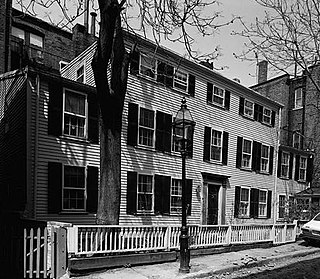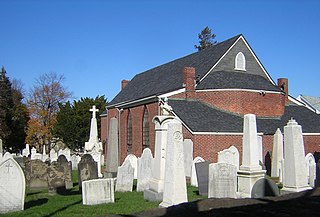
Dorchester is a neighborhood comprising more than 6 square miles (16 km2) in the City of Boston, Massachusetts, United States. Originally, Dorchester was a separate town, founded by Puritans who emigrated in 1630 from Dorchester, Dorset, England, to the Massachusetts Bay Colony. This dissolved municipality, Boston's largest neighborhood by far, is often divided by city planners in order to create two planning areas roughly equivalent in size and population to other Boston neighborhoods.

Dorchester Heights is the central area of South Boston. It is the highest area in the neighborhood and commands a view of both Boston Harbor and downtown.

The Captain Lemuel Clap House (1767) is a historic house located at 199 Boston Street, Dorchester, Massachusetts. It is now owned by the Dorchester Historical Society, which opens the house for tours two afternoons per month. It is one of two Clapp Houses owned by the society that are listed on the National Register of Historic Places.

The William Clapp House (1806) is a historic house located at 195 Boston Street, Dorchester, Massachusetts. It is the headquarters of the Dorchester Historical Society and contains many items from the society's collections, including 19th century furnishings and local historical items. It is one of two Clapp Houses owned by the society that are listed on the National Register of Historic Places.

The James Blake House is the oldest surviving house in Boston, Massachusetts, United States. The house was built in 1661 and the date was confirmed by dendrochronology in 2007. It is located at 735 Columbia Road, in Edward Everett Square, just a block from Massachusetts Avenue. The Dorchester Historical Society now owns the building and tours are given on the third Sunday of the month.

King's Chapel Burying Ground is a historic graveyard on Tremont Street, near its intersection with School Street, in Boston, Massachusetts. Established in 1630, it is the oldest graveyard in the city and is a site on the Freedom Trail. Despite its name, the graveyard pre-dates the adjacent King's Chapel ; it is not affiliated with that or any other church.

The Pierce House is a rare 17th-century house at 24 Oakton Avenue in the Dorchester neighborhood in Boston, Massachusetts. Built c. 1683, It documents period building practices, and the tastes and housing needs of one family, the Pierces, over more than three centuries. At different times, family members expanded and adapted their dwelling to meet new demands for space, function, comfort, privacy, and cleanliness.

The William C. Nell House, now a private residence, was a boarding home located in 3 Smith Court in the Beacon Hill neighbourhood of Boston, Massachusetts, opposite the former African Meeting House, now the Museum of African American History.

Dorchester Temple Baptist Church is a historic African American Baptist church at 670 Washington Street in Boston, Massachusetts. It is now known as Global Ministries Christian Church.

Saint Augustine Chapel and Cemetery is a historic church on Dorchester Street between West Sixth and Tudor Streets in the South Boston neighborhood of Boston, Massachusetts. Built in 1818–19, it is the oldest Roman Catholic church building in Massachusetts; the cemetery, established 1818 is also the state's oldest Catholic cemetery. The Gothic Revival chapel was originally built as a crypt for the remains of Father François Matignon, the first Catholic priest to come to Boston from France. Father Dennis J. O'Donovan and many other priests are also buried there.

The Boston Consumptives Hospital is a historic tuberculosis hospital in the Mattapan neighborhood of Boston, Massachusetts. It consists of a complex of eighteen historic buildings on 52 acres (21 ha) of land. Most of these buildings were built between 1908 and 1932, although the Superintendent's House predates the hospital's construction; it is an Italianate house built c. 1856. They are predominantly brick buildings that are Colonial Revival in character, although the 1929 main administration building has a variety of different revival elements. Several of the buildings on the campus—The Administrative or Foley Building; The Doctor's Residences, Dormitories and Wards; and The Power House—were designed by the renowned architectural firm Maginnis and Walsh. The complex was the largest tuberculosis hospital in the state, built in response to reports that the disease was responsible for more deaths than any other in the city. The facility was used for the treatment of tuberculosis through the middle of the 20th century, and then stood largely vacant until 2002, when plans were laid to rehabilitate the property for other uses.

The Codman Square District is a historic district in the Dorchester neighborhood of Boston, Massachusetts. It consists of four of the most prominent properties facing the main Codman Square intersection, where Talbot Avenue and Washington Street cross. The area has a long history as a major civic center in Dorchester, and is now one of the large neighborhood's major commercial hubs. The properties in the district include the 1806 Congregational Church, the 1904 Codman Square branch of the Boston Public Library, the former Girls Latin Academy building, and the Lithgow Building, a commercial brick structure at the southeast corner of the junction that was built in 1899.

The Lucius Clapp Memorial is a historic library building in Stoughton, Massachusetts. The single story masonry Renaissance Revival structure was built in 1903. It was Stoughton's first purpose-built library building, and was built on the site of its first schoolhouse. The building was designed by Walter Atherton and given to the town by Lucius Clapp, a local schoolteacher and businessman. It now houses the Stoughton Historical Society.
Thomas Wiswall (1601–1683) was an early settler of British America, a prominent early citizen of the Massachusetts Bay Colony, and a key figure in the founding of Cambridge Village, now known as the city of Newton, Massachusetts.

John A. Fox (1835–1920) was an American architect. Fox practiced in Boston for fifty years and is best remembered for his works in the Stick Style.
Clapp is an English surname, most commonly found in the West Country and in the United States. The word signifies rough ground, or a small hill.

Roger Clapp (1609–1690) was an early English colonist who settled in Dorchester, Massachusetts and served as a military and political leader in early colonial Massachusetts.

The Dorchester Historical Society is a non-profit historical society devoted to telling the history of Dorchester, Massachusetts since it was founded in 1630. The Dorchester Historical Society was "founded in 1843 and incorporated in 1891." The Historical Society is headquartered in the William Clapp House and also operates several other historic house museums in Dorchester, including the James Blake House (c.1661), and Captain Lemuel Clap House which are open for tours on third Sunday of each month from 11 AM to 3 PM.
Clapp House may refer to:



















